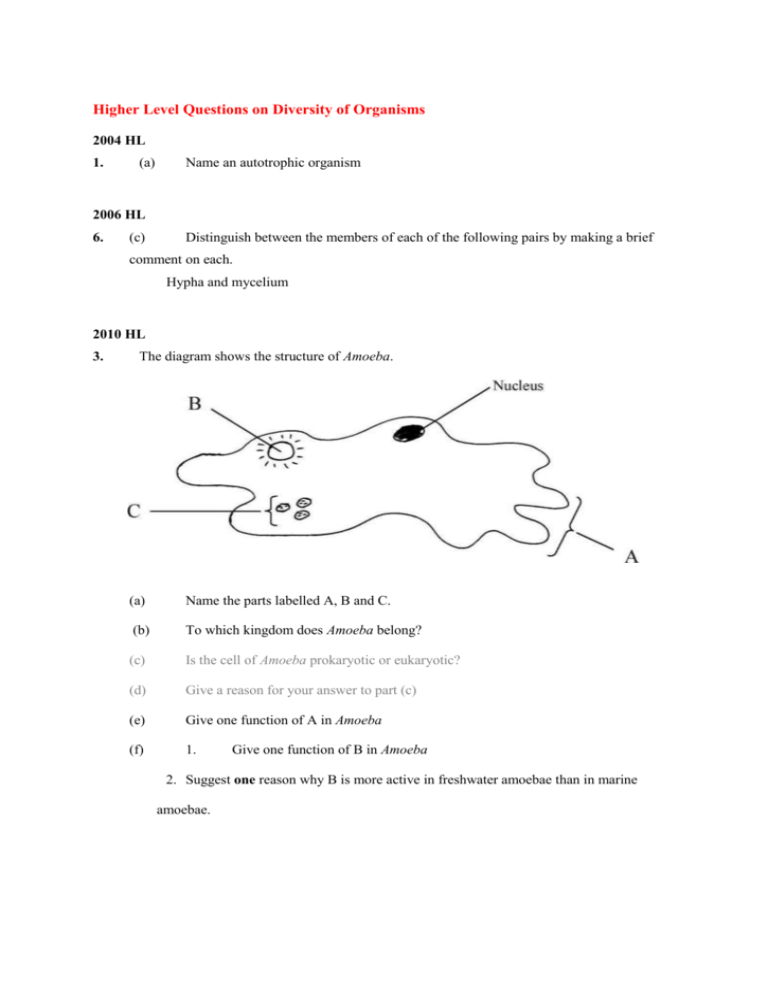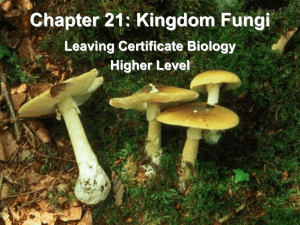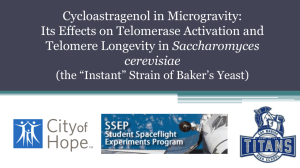Diversity of Organisms
advertisement

Higher Level Questions on Diversity of Organisms 2004 HL 1. (a) Name an autotrophic organism 2006 HL 6. (c) Distinguish between the members of each of the following pairs by making a brief comment on each. Hypha and mycelium 2010 HL 3. The diagram shows the structure of Amoeba. (a) Name the parts labelled A, B and C. (b) To which kingdom does Amoeba belong? (c) Is the cell of Amoeba prokaryotic or eukaryotic? (d) Give a reason for your answer to part (c) (e) Give one function of A in Amoeba (f) 1. Give one function of B in Amoeba 2. Suggest one reason why B is more active in freshwater amoebae than in marine amoebae. Ordinary Level Questions on Diversity of Organisms SEC Sample Paper OL 2. Bacterial cells have three main shapes. Two of these are shown below. Name each shape. Bacteria reproduce asexually by dividing in two. What term is used for this form of asexual reproduction? What do bacteria form when environmental conditions become unfavourable? What does the term pathogenic mean in relation to bacteria? 2005 OL 6. (a) The diagram shows the structure of Amoeba. (i) Name A, B, C, D. (b) (ii) To which kingdom does Amoeba belong? The diagram shows the structure of a typical bacterium. (i) Name A, B, C, D. (ii) To which kingdom do bacteria belong? …………………………………………… 2006 OL 6. The diagram shows a yeast cell, which is undergoing asexual reproduction. A.B. DOWSETT/SCIENCE PHOTO LIBRARY (a) Name A and B (b) What type of asexual reproduction is shown in the diagram? (c) Which type of division, mitosis or meiosis, is involved in this form of reproduction? (d) If yeast cells are kept under anaerobic conditions, alcohol (ethanol) and another substance are produced. (i) What are anaerobic conditions? (ii) Name the other substance produced. 2011 OL 4. Indicate whether each of the following statements is true (T) or false (F) by drawing a circle around T or F in each case. Example: The liver produces bile T F F (e) Rhizopus is a member of the animal kingdom. T 2012 OL 2. Amoeba is a tiny, one-celled organism. This diagram shows the structure of a freshwater Amoeba as seen through a microscope. (a) Name the parts labelled A, B, C and D. (b) State: one function of part A. one function of part C. (c) Give one difference between a plant cell and an amoeba. F 3.1 Diversity of Organisms Section B Higher Level Questions Ordinary Level Questions Higher Level SEC Sample Paper HL 8. (a) To which kingdom do yeasts belong? State one way in which yeast is beneficial to humans (b) Answer the following by reference to an experiment that you have carried out to investigate the growth of leaf yeast. Name the nutrient medium on which you grew the yeast Why was a nutrient medium necessary? From what plant did you obtain the yeast? Describe how you transferred the yeast to the nutrient medium Outline the procedures that you followed after you transferred the yeast to the nutrient medium. 2005 HL 9. (a) (i) (ii) (b) Yeasts are eukaryotic organisms. What does this mean? To which kingdom do yeasts belong? Answer the following questions in relation to an experiment that you carried out to investigate the growth of leaf yeast. (i) From which plant did you collect the leaf sample? (ii) Describe how you collected the leaf sample. (iii) What did you do with the leaves when you returned to the laboratory? (iv) Nutrient agar plates are used in this experiment. What are nutrient agar plates and what is their purpose? (v) What did you observe in the agar plates at the end of the experiment? (vi) Having finished the experiment, what did you do with the agar plates? 2007 HL 8. (a) (i) Name a fungus, other than yeast, that you studied during your course. (ii) Give one way in which the fungus that you have named in (i) differs from yeast. (b) Answer the following questions in relation to your investigation of the growth of leaf yeast. (i) It was necessary to use a nutrient medium. What is a nutrient medium? (ii) Name the nutrient medium that you used. (iii) The nutrient medium should be sterile. Explain the underlined term. (iv) Describe, in words and/or labelled diagram(s), how you conducted the investigation. (v) What was the result of your investigation? 2010 HL 8. (b) For which purpose did you use each of the following in the course of your practical studies? (iv) 1. Antiseptic wash solution in the investigation of the growth of leaf yeast on agar plates. 2. Petroleum jelly in the investigation of the growth of leaf yeast on agar plates. 2012 HL 8. (a) (i) Are fungi prokaryotic or eukaryotic? (ii) Name one structure in plant cells not found in fungi. (b) (i) What is the purpose of using agar when growing fungi or bacteria in the laboratory? (ii) Suggest one reason why leaf yeasts are more plentiful in July than in March. (iii) Describe how you introduced the leaf yeasts into agar plates. (iv) What was the precise purpose of a control in this investigation? (v) How did you recognise the leaf yeasts when they appeared on the agar? (vi) How did you safely dispose of the plates at the end of the investigation? (vii) Using the axes below, draw a graph to show how the number of leaf yeasts varied following their introduction into the plate. Ordinary Level 2008 OL 7. It is important to use sterile apparatus when working with micro-organisms. (a) (i) What is meant by sterile? (ii) How may apparatus be sterilised? (b) Answer the following questions about an investigation that you carried out to show the growth of leaf yeast. (i) Name the container in which you grew the leaf yeast (ii) What was present in this container to provide food for the yeast? (iii) Describe how you put leaf yeast into the container. (iv) How long did it take for the leaf yeast to appear? (v) Describe the appearance of the leaf yeast in the container. 2011 OL 7. (a) Draw a labelled diagram of a single, reproducing, yeast cell. (b) Answer the following questions in relation to your investigation into the growth of leaf yeast. (i) From what plant did you obtain the yeast? (ii) Name the nutrient medium on which you grew the yeast. (iii) Outline the steps you followed to get the yeast cells onto the nutrient medium. (iv) How long did it take for the yeast to become visible on the nutrient medium? (v) How did you recognise the yeast? (vi) Describe one aseptic technique you carried out during this investigation. Higher Level Questions on Diversity of Organisms Section C 2004 HL 15. (c) (i) Draw a labelled diagram to show the structure of Rhizopus. State one feature in your diagram that indicates that Rhizopus belongs to the kingdom Fungi. (ii) Sexual reproduction in Rhizopus leads to the formation of a zygospore. Show, by means of labelled diagrams, the stages involved in the production of the zygospore. (iii) Explain what happens when the zygospore reaches a location at which conditions for its germination are suitable. 2005 HL 15. cell. (b) (i) (ii) (iii) (iv) (v) Draw and label a diagram to show the basic structure of a typical bacterial Other than being prokaryotic, state two ways in which a typical bacterial cell differs from a typical human cell (e.g. cell from cheek lining). Describe how some bacteria respond in order to survive when environmental conditions become unfavourable. What is meant when a bacterium is described as being pathogenic? What are antibiotics? Use your knowledge of the Theory of Natural Selection to explain the possible danger involved in the misuse of antibiotics. (30) (c) Saprophytic and parasitic fungi are widespread in nature. (i) Explain each of the underlined terms. (ii) State a role of each of these types of fungus in the overall scheme of nature. (iii) Give one example of a beneficial fungus and one example of a harmful fungus. (iv) State a function for each of the following structures that are found in fungi; rhizoid, sporangium, gametangium, zygospore. (30) 2006 HL 15. (b) Answer the following in relation to bacteria. (i) Distinguish between photosynthetic and chemosynthetic bacteria. Give an example of each type. (ii) Name two forms of heterotrophic nutrition found in bacteria. (iii) What are antibiotics? For what purpose are they used? (iv) Explain what is meant by antibiotic resistance and suggest how it may develop. (30) 2007 HL 14. 30) Answer any two of (a), (b) and (c). (b) (30, (i) Comment on the difficulty of defining viruses as living organisms. (ii) What are the two main biochemical components of a virus particle? (iii) Name two diseases caused by viruses. (iv)Give an example of a beneficial application of a virus. (v) What is an antibiotic? (vi) Antibiotics should not be prescribed for a person suffering from a viral infection. Suggest a reason for this. 2008 HL 15. (c) The diagram shows a bacterial growth curve. (i) A and B represent the labels on the axes. What does each of them stand for? (ii) What term is applied to the part of the curve labelled x? What is happening during x? (iii) What term is applied to the part of the curve labelled y? What is happening during y? (iv) Copy the diagram into your answer book and continue the curve to show the next phase. Explain why you have continued the curve in this way. (v) Distinguish between batch and continuous flow food processing using microorganisms in the food industry. 2009 HL 14. (c) (i) Identify the organism shown in the diagram. (ii) To which kingdom does this organism belong? iii) Name the parts labelled A, B and C. (iv) 1. Give a role, other than anchorage, for structure X. 2. Describe how X carries out this role. (v) Which term describes the mode of nutrition of this organism. (vi) The cells of this organism are described as eukaryotic. Give two characteristic features of eukaryotic cells. (vii) What corresponding term is used to describe bacterial cells? 2010 HL 15. Answer any two of (a), (b), (c). (30, 30) (c) Suggest a biological explanation for each of the following observations: (i) As long as a baby feeds regularly from its mother’s breast (or if a breast pump is regularly used) the milk will continue to flow. (ii) Doctors are reluctant to prescribe antibiotics to patients suffering from common cold-like symptoms. 2011 HL 14. (c) (viii) Name the structure by which Amoeba gets rid of excess water that has entered by osmosis. 2011 HL 15. (c) The diagram below shows part of the mycelium of the fungus Rhizopus. (i) Give the name and state a function of the part labelled A. (ii) Name part B and explain why the reproduction associated with it is asexual. (iii) The nutrition of Rhizopus is described as being saprophytic. 1. What does the term saprophytic mean? 2. Explain the importance of saprophytic nutrition in the overall scheme of nature. (iv) Saprophytic nutrition is a form of heterotrophic nutrition. What does the term heterotrophic mean? (v) Name another form of nutrition employed by some fungi. (vi) Give two examples of harmful members of the kingdom Fungi. 2012 HL 14. Answer any two of (a), (b), (c). (30, 30) (c) (i) mould Rhizopus. Answer the following questions in relation to sexual reproduction in the 1. Sexual reproduction in Rhizopus is normally triggered by an adverse environmental stimulus. Suggest one such stimulus. 2. Draw diagrams to show the main events of sexual reproduction in Rhizopus. In your diagrams label three structures other than the zygospore. 3. Give two advantages to Rhizopus of zygospore formation. (ii) Answer the following questions in relation to asexual reproduction in yeast. 1. What term is used to describe the process of asexual reproduction in yeast? 2. What happens to the new cells formed in the process? 3. How does asexual reproduction in Rhizopus differ from that in yeast? Ordinary Level Questions on Diversity of Organisms SEC Sample Paper OL 15. (b) The diagram shows part of Rhizopus. (i) To which kingdom does Rhizopus belong? (ii) Name the parts A, B, C. (iii) State a function of part B. (iv) What takes place in part C? (v) Name another member of the kingdom to which Rhizopus belongs, other than yeast, and explain how it is of benefit to humans. (vi) Name another member of the kingdom to which Rhizopus belongs, other than yeast, and explain how it is harmful to humans. (30) 2005 OL 15. Answer any two of (a), (b), (c). (30,30) (c) The diagram shows part of the mycelium of Rhizopus. (i) Identify A, B, C. (ii) State a function of B. (iii) State a function of C. (iv) What term is used to describe the nutrition of Rhizopus? Explain the importance of this type of nutrition in nature. (v) To what kingdom does Rhizopus belong? (vi) Name another organism that you have studied in your biology course that belongs to the same kingdom as Rhizopus. 2007 OL 13. (a) The diagram shows a typical bacterial cell. (i) Some bacteria have a layer outside the cell wall (labelled A in diagram). Name this layer and state its function (ii) Name a structure, other than A, which is not found in all bacteria. (9) (b) The table below shows ways in which bacteria obtain their food. Study the table and then answer the questions that follow. Autotrophic Photosynthetic Chemosynthetic Heterotrophic Parasitic Saprophytic (i) Distinguish between autotrophic and heterotrophic nutrition. (ii) What is saprophytic nutrition? (iii) Why are saprophytic bacteria important in nature? (iv) Briefly explain chemosynthesis. (v) What term is used for the organism from which a parasite obtains its food? (vi) Give examples of two harmful bacteria. (24) (c) (i) (ii) (iii) (iv) Draw a labelled diagram to show the structure of Rhizopus. Rhizopus uses both sexual and asexual reproduction. Give a brief account of its asexual reproduction, using diagrams. The diagrams show stages of sexual reproduction of Rhizopus. Name the parts labeled A and B. What is the function of B? (27) 2008 OL 15. (c) Answer the following by reference to Rhizopus. (i) To which kingdom does Rhizopus belong? (ii) Draw a diagram to show the structure of Rhizopus and label three parts. (iii) Describe, using labelled diagrams, sexual reproduction in Rhizopus. (iv) Give an example of a beneficial organism and of a harmful organism that belong to the same kingdom as Rhizopus. 2009 OL 12. (b) The diagram shows the structure of a typical bacterial cell. (i) Name the bacterial cell parts A, B and C. (ii) What is the function of C? (iii) Name any two of the main bacterial types (shapes). (iv) By which method do bacterial cells reproduce? (v) Some bacteria are anaerobic. What does this mean? (vi) What are pathogenic bacteria? (vii) Give two example of the economic importance of bacteria. 2010 OL 13. (a) (i) (ii) What is meant by a ‘balanced’ diet? Distinguish between autotrophic nutrition and heterotrophic nutrition. (9) 2010 OL 15. Answer any two of the parts (a), (b), (c). (30, 30) (c) Rhizopus is a type of mould often found growing on stale bread. (i) Draw a diagram of Rhizopus and on it label a hypha, a sporangium and a sporangiophore. (ii) Explain how Rhizopus gets its food. (iii) What form of heterotrophic nutrition does Rhizopus have? (iv) Outline the importance of this type of nutrition in nature. (v) To what kingdom does Rhizopus belong? (vi) Name one economically harmful member of this kingdom. (vii) Mushrooms also belong to this kingdom. A restaurant owner decides to collect and cook wild mushrooms from a local forest. Suggest one reason why this may not be a good idea. 2012 OL 13. (a) All organisms may be classified (grouped) into five kingdoms. (i) Suggest one advantage of classifying organisms. (ii) Name the kingdom to which bacteria belong. (iii) Give one example of the economic importance of bacteria. (9) (b) (i) (ii) (iii) (iv) (v) (c) Draw a large labelled diagram of a typical bacterial cell. Bacteria may be classified by their shape. Name any two bacterial shapes. Name the method by which bacteria reproduce. What are pathogenic bacteria? State two factors affecting the growth of bacteria. (27) The diagram shows part of the fungus Rhizopus. (i) Name the parts labelled A and B. (ii) Give two functions of structure B. (iii) Describe the role of part C in the reproduction of Rhizopus. (iv) What is meant by saprophytic nutrition? (v) Give one beneficial use of fungi. (24)








